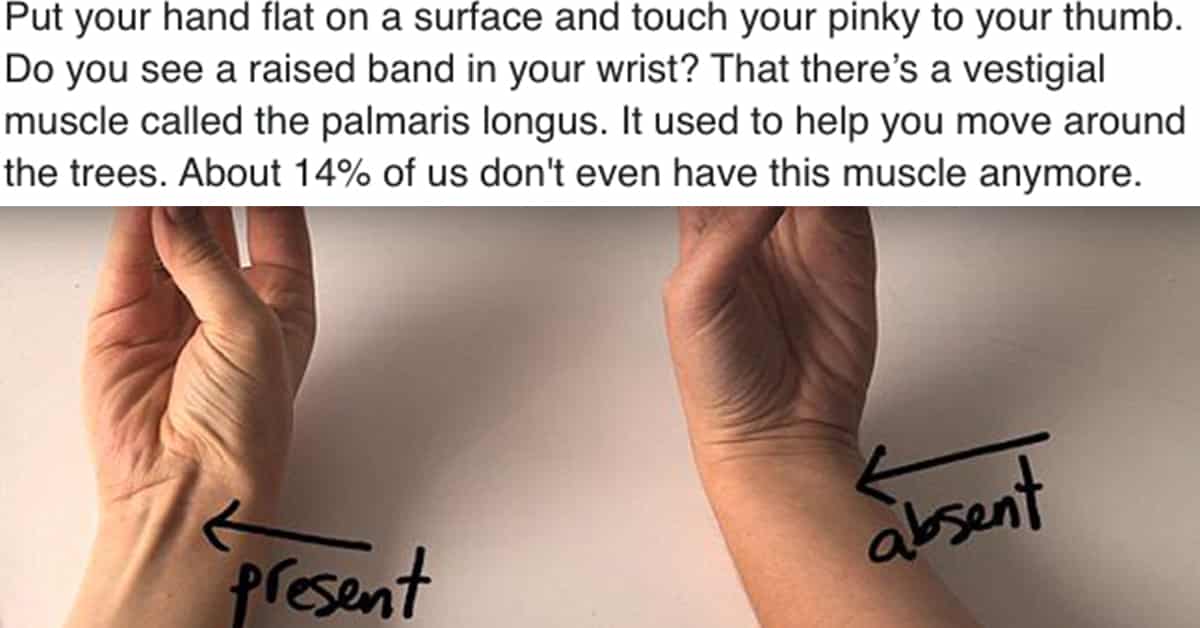Scientist Shares The Freaky Useless Stuff Leftover On Human Bodies Via Evolution
Homo Sapiens like to think we’re far more evolved than our closest primate cousins (some even like to think that evolution isn’t real at all, but they have a lot of other issues). In reality, our bodies still include many of the telltale signs of primate life. These are “vestigial” pieces, things that no longer have a purpose because we don’t need them anymore, but will still show up on our bodies.
Evolutionary anthropologist Dorsa Amir created a thread about all of these “evolutionary leftovers” that has started circulating again, perhaps because being stuck inside with their bodies has made people more aware of them. Going through her list, it’s fun to see which ones you have.
Did you know the human body is full of evolutionary leftovers that no longer serve a purpose? These are called vestigial structures and they’re fascinating. (1/8)
— Dorsa Amir (@DorsaAmir) January 15, 2019
For example, she writes of the human wrist, “There’s a vestigial muscle called the palmaris longus. It used to help you move around the trees. About 14% of us don’t even have this muscle anymore.”
Did I check on myself? You better believe it. And no, I do not have the muscles to swing through trees, sadly.
Put your hand flat on a surface and touch your pinky to your thumb. Do you see a raised band in your wrist? That there’s a vestigial muscle called the palmaris longus. It used to help you move around the trees. About 14% of us don’t even have this muscle anymore. (2/8) pic.twitter.com/ZF3Ta91IGy
— Dorsa Amir (@DorsaAmir) January 15, 2019
I do have extremely knobbly ears, which means my family branch has been moving their ears around quite a lot over the last few millennia. Makes sense. We love gossip.
Check out your ear. Do you see this little bump? That’s called Darwin’s tubercle. It used to help you move your ears around. Now that we have super-flexible necks, we don’t need these anymore. (3/8) pic.twitter.com/2OlVWEu6gT
— Dorsa Amir (@DorsaAmir) January 15, 2019
No tailbone, unless it was removed when I was a baby:
Here’s a more obvious one: the tailbone. This is the ghostly remainder of our lost tails, which were useful for balance & movement in trees. We still grow tails as embryos, but then attack and destroy them in the following weeks. Not the most efficient system. (4/8) pic.twitter.com/pmF2lCpnyT
— Dorsa Amir (@DorsaAmir) January 15, 2019
I also have this goopy little pink thing, which was once much larger for all of us, creating an additional eyelid, like you might see on a cat:
Ever wonder what this little pink thing in your eye is? This is the plica semilunaris. It used to be a third eyelid that would blink horizontally. You can see this in action in the eyes of many other animals. (5/8) pic.twitter.com/0ubMulahA0
— Dorsa Amir (@DorsaAmir) January 15, 2019
If you get goosebumps, you’re just trying to get bigger to scare away predators. Imagine how hairy you’d have to be for that to work:
Oh, and you know how you sometimes get goosebumps when you’re cold or scared? That’s a vestigial reflex that used to raise body hair to make you appear bigger or trap an extra layer of heat for warmth. Some people can actually do this on purpose. (6/8) pic.twitter.com/uY2zJddguy
— Dorsa Amir (@DorsaAmir) January 15, 2019
Even babies have stuff they don’t need:
Another cool reflex is the palmar grasp reflex. If you place your finger on an infant’s palm (or feet!), they will try to grasp it. Ancestral primate babies would have used this to grasp on to their parents for transport. (7/8) pic.twitter.com/LFpN1ykSug
— Dorsa Amir (@DorsaAmir) January 15, 2019
Amir also tried to make a distinction between something being non-functional rather than vestigial, like nipples on someone who doesn’t lactate. Humans developing in the embryo could go either way, so they all develop nipples even if only half of them are technically “useful.”
A few addendums:
Wisdom teeth — yes, though still ~functional for original purpose.
Appendix — potentially yes, though it still seems to do stuff (may have been repurposed).
Male nipples — though technically non-functional, not quite vestigial. Due to embryonic development.
— Dorsa Amir (@DorsaAmir) January 16, 2019
Good question! In most cases, vestigiality is determined by comparing to related animals, considering what function those traits are serving for them, and whether they still serve the same function for us. Check out this woolly monkey to see what this grasp reflex is used for. pic.twitter.com/0JRgo0hZio
— Dorsa Amir (@DorsaAmir) January 15, 2019
Now, when will humans evolve past slinging sh*t when they’re mad?
More super interesting Twitter threads:
- Biologist Explains How To Make Your Own Yeast In Viral Twitter Thread
- Buckle Up, This Viral Thread Could Teach You More About Triscuits Than You Probably Ever Wanted To Know (10 Pics)
- Man’s Twitter Thread About Proposing To His GF With A Pawn Shop Ring He Hid For Three Years Goes Viral
- Viral Thread Has Twitter Wondering If People Aged Faster In The Past (25 Tweets)

